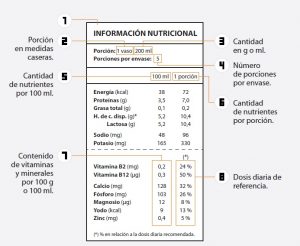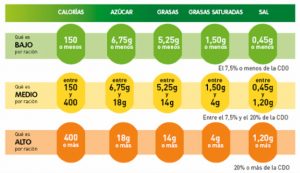As well as knowing how much energy the foods we consume provide us with, it is also important to know what we are really eating. We should therefore look at the nutrients they contain and the quantity. When we pick up a product and look at its label, we usually find information we do not how to interpret correctly. We have given you some tips below that will help you understand more easily what it all means.
- The ingredients are listed in order of importance, depending on the amount of the product, e.g. if we look at a yoghurt label, the first ingredient to appear will be milk. On this list, we will find certain ingredients in bold: these are products that could give rise to allergic reactions and intolerances.
This is the section where we can really find out what types of fat and sugar the product contains. In addition, it is very important to look at this list, because we often find misleading messages in food labelling that try to persuade us that the product is healthier than it really is, so you should always look closely at the list of ingredients and the nutritional information given.
- The labelling includes the amount of nutrients per 100g of product and is usually accompanied by the amount provided by the product for each recommended serving, which will vary depending on the food. For example, one serving of cocoa powder corresponds to one teaspoon, but, however, the recommended serving of breakfast cereals is 30g.
- Along with the nutritional information, we can see the size of the portion indicated. This section shows how many servings there are in the packet and the size of each serving. For example, the label on a bar of chocolate indicates that there are 7 portions in each bar and each portion is equivalent to 5 squares of chocolate.
- In addition, the percentage reference intake of an average adult is usually included. In other words, the average number of calories recommended for an adult who needs 2,000 Kcal a day and is usually indicated as RI. Together with this value, the percentage corresponding to each nutrient is determined.

Nutritional information:
- The energy value indicates the calories provided by the food for each 100g of product or for each recommended serving. It can be expressed in two types of unit: kilojoules or kilocalories (the latter being more used). As we have already mentioned, it is important to know how much energy the food provides, but it is almost more important to know where these calories come from, and whether or not they benefit our body.
- Fats: the total amount of fat is an important value, but we should not stop at that. Feeding ourselves with one kind of fat is not the same as using another. Fats of vegetable origin, such as those from olive oil or nuts, are very good for the heart, since they provide us with monounsaturated and polyunsaturated fats (this group includes the famous Omega 3 and Omega 6). In contrast, fats of animal origin (mainly saturated fats), hydrogenated or trans fats (often to be found in products such as snacks, crisps, or factory-produced bakery products) and some vegetable fats, such as coconut or palm oil, are closely related to high cholesterol levels and the appearance of cardiovascular diseases. The label always indicates the amount of total fat and which type of fat each belongs to.
- Carbohydrates (CHs) can be classified as complex or simple. Complex CHs are to be found in wholefood products (bread and brown rice, vegetables and legumes), this group has numerous benefits for our health, so whenever possible we should use these wholefood products. Conversely, simple CHs are sugars (sucrose, fructose and lactose) and should be consumed in moderation. Although it can be hard to believe, these sugars are very often present in most of the products we consume on a daily basis: the proof is there if we look at the list of ingredients.
- Fibre is a nutrient that aids digestion and has many other health-related benefits. It is naturally present in foods such as vegetables, nuts, and wholemeal cereals. Foods with more than 3g of fibre per 100g of food are considered adequate sources of fibre, and those with more than 6g of fibre per 100g of product are high considered high-fibre.
- Proteins are the main constituent of our body’s cells. There are two groups of proteins, depending on their origin: those of animal origin (eggs, fish and meat) and those of vegetable origin (nuts, rice and legumes). We have minimum daily requirements, but most people in developed countries consume animal-based proteins far in excess of what they require.
- Salt or sodium chloride (NaCl) can be found naturally in food or is added later. Generally, we consume much more salt than we need and most of it comes from pre-cooked or processed products. The WHO recommends consumption of less than 5g (less than one teaspoon per day).
In addition, it is important to know the difference between:
- Best before: date until which the food retains all its properties (texture, smell, taste…), but the food is still safe after that date has passed.
- Use by: indicates when the food is no longer fit for consumption.To sum up, basing our purchase of the foods that comprise our everyday diet on their labels is a way of achieving a healthier way of eating, recognising the nutrients that are good for our body and those that can only do us harm.Below you will find our nutritional traffic light system: this serves to identify if a serving of a product provides us with a low, medium or high content of calories and nutrients (sugars, fats, saturated fats and salt).
To sum up, basing our purchase of the foods that comprise our everyday diet on their labels is a way of achieving a healthier way of eating, recognising the nutrients that are good for our body and those that can only do us harm. In addition, we offer you some tips to further improve your shopping:
- It’s better to make a planned purchase. The more we improvise, the more likely we are to buy unhealthy food. Our shopping list should reflect our daily or weekly menu plan.
- Prioritise fresh and natural foods over processed and packaged foods. Fresh and natural foods do not have many ingredients, and you should generally know all of them. Processed foods, on the other hand, often have long lists of ingredients that include unhealthy preservatives and other ingredients with little nutritional value.
- Include few occasional foods. One of the main enemies of healthy eating is the overuse of convenience foods such as soft drinks, pastries, and packets of snacks. Reducing the amount of these foods we buy is the best strategy to limit our consumption of them.
- It’s better to choose whole foods instead. A whole food is one that is eaten as it is produced by nature, so that it retains all its nutritional qualities.
- Be careful with drinks! Soft drinks, energy drinks, and similar beverages add a lot of calories to our diet without us realising it and without providing us with nutrients. It is important to remember that water is the best drink to choose.
- Does healthier equal more expensive? There is a belief that eating healthy means that our purchases are more expensive. However, processed products that are “trendy” and often consumed occasionally are expensive and do not provide us with the nutrients we need.
Below you will find our nutritional traffic light system: this serves to identify if a serving of a product provides us with a low, medium or high content of calories and nutrients (sugars, fats, saturated fats and salt).
 ** The TRAFFIC LIGHT SYSTEM was created by the Food Standards Agency of the United Kingdom.
** The TRAFFIC LIGHT SYSTEM was created by the Food Standards Agency of the United Kingdom.
https://www.food.gov.uk/business-guidance/nutrition-labelling
Image:Pixabay
